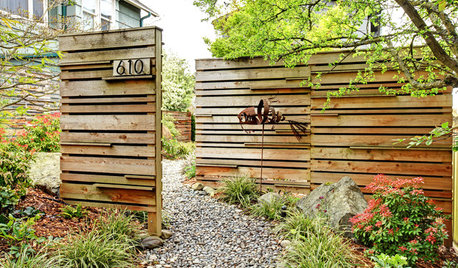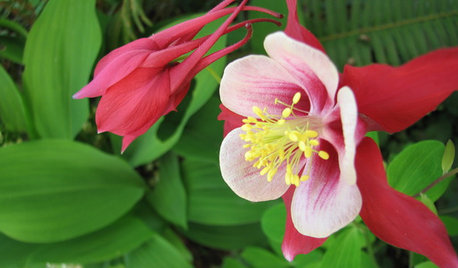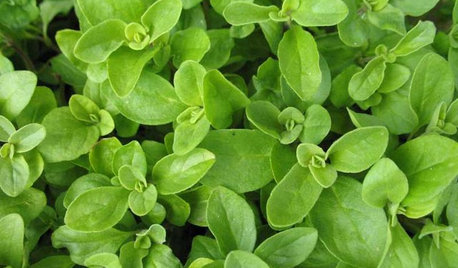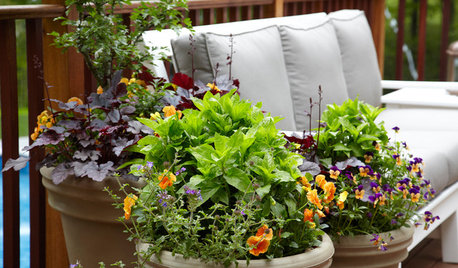chili peppers
I am totally confused what is a chili pepper.
this seems to be a large group and not just one. What started this was when i saw the use of chili peppers in recipes. want to put up salsa and relishes this year need definitions to pick what to plant
thanks this is a great place for info
Comments (20)
Macmex
9 years agolast modified: 9 years agoAs I understand, "chili pepper" refers to any hot pepper and excludes the sweet ones.
The term is derived from Spanish. In Spanish the term is spelled "chile" and is pronounced roughly the same as we say it in English.This is kind of like the term "savvy." We say that a cowboy has lots of horsemanship savvy. The term "savvy" is derived from the Spanish "sabe," pronounced much the same. "Sabe" in Spanish is the verb "he knows." In English, to be savvy means to be very knowledgeable.
Back around 2002, having recently returned from almost 14 years in Mexico, I purchased some small "chili plants" at Walmart. I chose those which were marked "Cayenne." They grew well and in August I noticed that they were the largest cayenne peppers I had ever seen. Hopefully, I picked one and ate a piece. It was so mild I could only just detect some heat. I passed a pepper to my son, who had lived almost his whole life in Mexico, asking him to try this "chile." Unsuspectingly, he took a bite, chewed and spit it out. His response was: "That's not a chili! That's a sweet pepper! Bleh!" In 2003, I purchased a a packet of "cayenne pepper SEED" at Walmart. I grew out some little plants and put them in the garden. They too grew and produced really large "cayennes." Once again, wanting with all my heart to have cayenne peppers, I tasted one. Once again I thought I detected just a little heat. I passed it to my son to try and his reaction was stronger than ever: "Bleh!!! That's not a chili! Both times they sold me Italian frying peppers!
To this day, if I pass my son a chili to try, he gives me a wary look and asks if it's legit.
So, that, in my opinion is how a chili is defined. It's a HOT pepper.
George
Tahlequah, OKchickencoupe
9 years agolast modified: 9 years agooldokie
I completely understand. Chilis weren't the top of my gardening priorities until I attempted to determine how to come up with the same chili flavor as the store-bought mild green chilis that I use in taquitos. Those were canned. Chilis vary wildly and the family is huge. For some reason I'm just not looking forward to growing and trying as much as I would tomatoes, but I must as my son seems to enjoy chili flavors. I'll let him do the testing lol
Related Professionals
Danbury Landscape Architects & Landscape Designers · Deer Park Landscape Architects & Landscape Designers · Ilchester Landscape Architects & Landscape Designers · Mountain Brook Landscape Architects & Landscape Designers · Otsego Landscape Architects & Landscape Designers · Frisco Landscape Contractors · Eureka Landscape Contractors · Huntington Landscape Contractors · Lake Zurich Landscape Contractors · Northbridge Landscape Contractors · West Chicago Landscape Contractors · Algonquin Decks, Patios & Outdoor Enclosures · Gaithersburg Decks, Patios & Outdoor Enclosures · Kalamazoo Decks, Patios & Outdoor Enclosures · La Palma Decks, Patios & Outdoor Enclosuresoldokie
Original Author9 years agolast modified: 9 years agowe are using a lot of those canned green chilies and tomatoes with chilies so i am looking for a way to do my own. I may try jalapenos but i think they may be a little strong for wife.
Okiedawn OK Zone 7
9 years agolast modified: 9 years agoWhen searching for a pepper variety to grow, often you can Google the variety name and the words Scoville Heat Units and come up with the Scoville Heat Unit rating for the peppers. Within each type of hot pepper, there are varieties with different levels of heat.
The higher the number assigned to peppers on the Scoville Scale, the hotter they are. Most peppers produce within a range of numbers, and the heat can be affected by growing conditions. Generally, the hotter and drier the weather, the hotter the peppers grow although they are genetically limited in how hot they can get.
Within the Jalapeno group, you can grow peppers with almost no heat to lots of heat.
There are jalapenos, for example, that are bred to have only the jalapeno flavor but little to none of the heat. Examples of these are Senorita (400 Scoville heat units) or Delicias(0-500).
Among the jalapenos that are bred to have a little heat you have TAM Mild 2 (1000-1500), Mammoth (1000-5000) or Tam Vera Cruz 1000-3500).
Jalapenos bred to have medium heat include Chichimeca (3500), Jalapeno M (3500-6000)
At the upper end of the Jalapeno group, the varieties bred to have a lot of heat include Biker Billy (3500-10,000), Ixtapa (4000-6000), Mucho Nacho (5000-8000), Grande (4000-6000), Early Jalapeno (4000-6000) and Purple Jalapeno (about 6000).
The higher the Scoville Heat Unit number assigned to a pepper, the hotter it is and you cannot tell if a pepper is hot or not just by looking at it. There are both mild and hot anaheim peppers and they look about the same, so you can pick and choose which variety you want to grow based on how high or low its SHU numbers are. This requires research on your part before you select specific varieties to grow from seed or to purchase.
When I make salsa I tend to use jalapenos if I am making the regular Annie's Salsa to can, but sometimes substitute serranos for some of the jalapenos if making salsa for my son to take in to work at the fire station, because those firefighters like salsa that is much hotter than the regular Annie's Salsa. Most of the jalapeno pepper varieties I grow are in the medium to hot range. I've tried the no-heat ones like Senorita and Delicias and they didn't have enough heat for me, and over time, I have grown to like hotter and hotter jalapeno peppers.I usually grow Mucho Nacho, Biker Billy Ixtapa, Grande' and Chichimeca,and sometimes add Gigantea and Big Guy to the list.
At the very high end of the Scoville Scale you'll find peppers whose heat is measured at 100,000 or higher, including the various Naga peppers and Habanero Peppers, some of which have tested higher than 300,000.
Serrano Peppers, often used in Salsa, can measure at 15,000-30,000 Scoville heat units. Thai Hot (often grown as ornamentals) can measure 50,000-100,000. Poblano/Ancho peppers usually are around 1,000-2,000, and Tabasco peppers come in somewhere between 30,000-50,000.
Anaheim peppers come in both hot and mild varieties, with the popular NuMex Big Jim testing at 500-2500. Banana Peppers also come in both mild and hot varieties, with the hot ones registering at 5,000-10,000 Scoville Heat Units.
If you are purchasing pepper transplants at a store, doing your research ahead of time will help you know how hot different varieties are so you can choose the ones you want. Bonnie Plants usually has the Scoville Heat Units for the pepper plants they sell listed on their website under the description for each specific variety. Some seed catalogs/websites list the Scoville Heat Units as a part of the variety description, but others don't.
I started out growing milder jalapenos and worked my way up to the hotter ones. With Anaheims, I usually only grow the hot ones, and I always grow habaneros for Habanero Jelly, but they're too hot for me to eat otherwise. Every now and then I grow Red Savina or Fatali. I sometimes put a little bit of habanero in a batch of salsa if someone has requested 5-alarm salsa. I never substitute all the habaneros for all the jalapenos because that makes a salsa so hot that very few people can eat it.
I usually start pepper seeds indoors at the same time as tomato seeds but transplant them outside 2-4 weeks later, depending on the weather, because they to not tolerate early spring's cool weather as well as tomato plants do.
I've linked the Wikipedia page on the Scoville Scale as it is very informative. Once you understand how the scale works and where various peppers fall on the scale, it is a lot easier to select varieties to grow. I have learned that my family and I prefer peppers in general that test no higher than 10,000 Scoville Heat Units, except we will use habaneros, fatalis, bird pepper, cayenne or tabasco peppers very sparingly in recipes.
Hope this helps.
Dawn
Here is a link that might be useful: Scoville Scale Wiki
Auther
9 years agolast modified: 9 years agoJoe E. Parker are a Anaheim type pepper from New Mexico. They are not real hot but have a very good chili pepper flavor. They taste like the little canned green chili peppers you can buy in the grocery.
Lisa_H OK
9 years agolast modified: 9 years agoGrowing conditions will affect the heat levels as well...or at least that has been my experience. The drier the year, the hotter the pepper.
chickencoupe
9 years agolast modified: 9 years agoHippie, thank you so much for the site! It's really helpful. I am reminded to try paprika peppers. I need those for chili and such.
thank you, Auther. So Joe E Parker? I'll order some and give it a whirl. Heck, it's bound to be closer than anything I can come up with.
oldokie, I'll try to remember to post results. We really enjoy those canned green chilies. They mix well in flavor with the cream cheese filling of taquitos. Sweet but with a unique bite.
Dawn, I've been using Cayenne in everything. That needs to change. Time to expand, I guess. Does roasting the peppers reduce the scoville?
chickencoupe
9 years agolast modified: 9 years agoLisa, that's interesting. Never know? I could always dry them up and use them as seasoning if they're too hot for the recipes. Maybe growing peppers won't be such a bore after all. I'm getting kinda excited.
Macmex
9 years agolast modified: 9 years agoSome years ago my brother in NJ ordered 14 different types of pepper plants from ChilePlants.com. He planted them all in their own garden and compared them for flavor and heat. I visited him while there were still some peppers in the garden (end of season). It was great to see all the variety and to taste it as well! I settled on Ají Yellow #2 as my favorite. But they were ALL good!
George
drew51 SE MI Z5b/6a
9 years agolast modified: 9 years agoI like to use green chili's too, and I use The Numex peppers. Heritage 6-4, Heritage Big Jim ,Joe E Parker and
Sandia. Other too like New Mexico, never tried that one. All have slightly different flavors.I also like to make my own sweet and hot paprika using the appropriate peppers. Mostly from Hungary, some from Spain, Poland, and Italy. Each region has it's own peppers for paprika.
You can find some good green chili's here, if you can grow from seed.
Here is a link that might be useful: Numex peppers
Okiedawn OK Zone 7
9 years agolast modified: 9 years agoBon, It is hard to apply a general statement to all the many hundreds of pepper varieties out there, but in general, fire-roasted peppers do not taste as hot to most people as they taste in their raw state. I am not sure if this occurs because roasting them actually increases the sweetness, which then might make them taste less hot and pungent, or if roasting breaks down some of the compounds within the capsaicin. Not surprisingly, research into this matter sometimes gives conflicting results. With habanero peppers roasted at a certain temperature (and it may have been 410 degrees Fahrenheit, I don't remember now), the heat actually increased. With something like jalapenos, though, fire-roasting usually gives them a smokey-sweet flavor and diminishes the heat somewhat, which I think explains why chipotles are so popular. I fire-roast some peppers, oven-roast some and leave the others raw, and then freeze them all for cooking. We like them all.
In general, the capsaicin that provides the hot flavor is a fairly stable alkaline oil, so it takes a little effort to neutralize it. I think that citrus juices like lemon and lime, which are more acidic, will neutralize it slightly and that's why they often are included in salsa or pico de gallo recipes. Sugar makes the heat of the peppers more bearable, which is why pepper jellies are popular even with people who normally more or less steer clear of hot peppers.
If you harvest peppers and find them too hot, you can (while wearing gloves, of course) cut into them and remove the white pithy membrane inside because that is where a large portion of the heat resides.
Depending on how you're cooking any given kind of pepper, and depending on what ingredients you're using it with, you can decrease the heat even more. I think boiling reduces the heat, but I'm not sure what frying does.
Dawn
Here is a link that might be useful: The Science of Hot Chiles
chickencoupe
9 years agolast modified: 9 years agoDawn, that article is the best I've read. I must clip this one and refer back to it since I learn from repetition. The grassy flavor? Had no idea that was my preference, but it also explains why some salsas seem offensive. Some are too grassy in flavor, me thinks. And the pectin? I always wondered why my chili was not consistent in thickness. I'm not consistent with the paprika. That's a lot of paprika for thickness, but if I make my own....
Drew51, would you mind cluing me in on shelf life and your storage method of dried peppers, like Paprika? Your preference at processing them? Hang dry? Do you blend the dried chilis into a powder? I guess a dedicated coffee grinder would work? Thanks for the link. I'm bookmarking.
Thanks for the thread, oldokie. A good study on chilis !
soonergrandmom
9 years agolast modified: 9 years agoBon, Don't be afraid to grow any kind of peppers, but warn your children which ones are hot. Since I wasn't home much last summer, I planted a few tomatoes and peppers at my son's farm. We ate a lot of the tomatoes and a few peppers, but after we came home in the Fall, the plants continued to produce. My son is a 'grazer' and would pause and eat a few cherry tomatoes as he passed by, etc. One day he called his Dad and asked him what those orange scrunched up peppers were that I planted at his house. Seems he had pulled a habanero and taken a bite in the garden. So even grown children make mistakes when they graze. LOL It's best to plant the hot ones on the opposites end of the garden from the sweet ones.
In my garden, peppers are about the easiest crop I grow, but there are a few rules. Some plants, like pablano, grow tall, and others, like bell peppers get so loaded with heavy fruit that they will fall over if not staked. Those cheap box store cages that they sell for tomatoes (and don't work for tomatoes) are usually enough support for a pepper. I sometimes see pictures of peppers growing in a field that aren't staked, but that doesn't work in my garden and they fall over just like a tree falls and bring the roots up with them. Don't get in a hurry to plant them outdoors and wait to the weather is warm. I always wait at least 2 weeks after the last expected frost, and sometimes more. I plant them closer than most crops because a big bell pepper taking full sun will sometimes get sunscald on the fruit, but you have to leave room for a cage. I don't have much trouble growing hot peppers except they are always so late in my garden. I'm not happy unless I have a dozen, or so, different types of peppers growing in my garden. I like almost all types of peppers except banana. They just taste bitter to me regardless of the ripeness and its a taste I don't like. I like a lot of the 'cowhorn' shaped peppers, especially yellow ones, and I love having poblano peppers for cooking, although I have never had mine grow as large as the grocery store ones. One year I had so many that I just got tired of picking them and a friend that I had supplied for several months, came over a couple of times and picked all that were left.
One year George (macmex) sent me seed for a small chili pepper that I think he called Frank's Thai Chili. It is a hot, but I dry it, pop the stem off, then put it in the blender and grind it to a powder. I put it in a shaker bottle and Al keeps it with the salt and pepper shaker and shakes it on just about everything. One bottle will last a long time because it only takes a shake or two to add plenty of spice. My son likes spicy pickles so when I make dill pickles for him, I make an inch long cut down one of these fresh little red peppers and add to each jar.
When the peppers start coming faster than we can use them, I freeze them for future meals. I chop bell peppers, and some I cut into strips like I want for fajitas, especially when I have lots of ripe peppers in different colors. Some bags I do both bell peppers and jalapenos and label them them "spicy" so I know which bag to grab for Mexican food.
Ever since oldokie posted this thread, I have had a craving for poppers. Somehow you just can't go wrong with a jalapeno, filled with cream cheese and a slice of Wright's bacon wrapped around it. I like them fresh and hot out of the broiler, but will also eat them cold if I happen to have leftovers.
I have never had a pest problem with peppers, so that's a plus. I ordered two new peppers this year which I haven't grown before, Antohi Romanian and Bell Aconcagua.
Hope oldokie doesn't mind that I hijacked his thread by talking about sweet peppers also, but peppers are peppers and I like lots of them.
AmyinOwasso/zone 6b
9 years agolast modified: 9 years agoThis IS a good thread! Dawn, I liked that article, too. I am not fond of hot peppers. The older I get the more the heat overwhelms my mouth and irritates my stomach. And what is the deal with internet recipes? They all add hot pepper flakes. BUT, I bought seeds for a Czechoslovakian Black pepper which is supposed to be on the same heat level as jalapenos. My grandfather was Czech (Bohemian) and, well, BLACK. I couldn't wait to try them and planted them late last year. One is growing on the bedroom window sill. It had gorgeous large lavender blooms (in December!) And currently has 5 deep dark purple peppers on it. Apparently they turn red when fully ripe, like jalapenos. I don't care what they taste like, the plant is so beautiful I will grow it for it's looks.
Okiedawn OK Zone 7
9 years agolast modified: 9 years agoBon, I am glad you found the article helpful. The amount of pepper varieties available is mind-boggling and you can have fun growing new ones every year for the rest of your life if you want. There's so many that you'll never run out of new ones to try.
In fact, there are 5 new hybrid pepper varieties among the 2015 All-American Selections national winners. I've never seen 5 different varieties of any one vegetable win in the same year.
With almost all peppers, I prefer to let them stay on the plants until they reach their mature color, but I'll harvest bell peppers in the green stage and use them in Annie's Salsa if the tomatoes, garlic, onions, cilantro and jalapenos are ready to use.....I'm not going to hold up the whole canning process waiting for the bell peppers to go from green to red, orange or yellow. I just like the richer, fuller flavor of colored peppers. I suspect it is the commercial growers/grocery industry that has convinced us all to eat our bell (and other) peppers green---because green peppers have a longer shelf life. If growers wait and harvest the peppers at their mature color, the shelf life is much shorter.
Carol, We've had that happen before, even when we've warned someone "don't take a bite of that one, it is really hot". They always think "how hot can it be" and then they find out exactly how hot.
Some years I have grown the regular orange Habanero pepper as well as NuMex Suave Orange Habanero, which was bred to eliminate almost all the heat. (I think it is around 300-500 Scoville Heat Units.) To someone who doesn't raise these peppers, these two can be hard to tell apart, although the Suave Orange is more of a yellowish-orange than the regular orange Habanero. I always harvest them separately, placing them in plastic containers in the garden that are clearly labeled at the moment of harvest, and I store them in clearly-labeled zip lock bags, and still there will be some point at which a person mistakes the hot one for the low-heat one and lives to regret it
Carol, Talking about peppers made me crave poppers too. I've made three batches since this thread began.
Every year I am getting better yields than before with poblanos, which is interesting because for so very long they just would not produce much here. They have produced well since either 2011 or 2012. I'm growing a new one this year called Mosquetero. They are supposed to grow to 6" long x 3" wide and the plants are supposed to be heavy producers. I guess I'll find out if those things are true.
Amy, I love finding varieties that I remember my dad, grandfather or one of my uncles growing. My dad told me once that "you can't find Amish Moon and Stars watermelon any more", and that was long before I found and started growing heirloom varieties, so I was thrilled when I found it and was able to grow it. I also grow at least one Big Boy tomato plant every year because he always grew it. He loved Big Boy and often about half the tomato plants in his garden would be Big Boy. I like having it in the garden because it reminds me of him.
I generally dry some of each type of hot pepper that I make and make my own flakes for use in cooking. When properly dehydated, they store forever, and I can choose which kind of flakes I want to use while cooking.
There are lots of pepper plants that I think are worthy of growing as ornamentals whether a person likes to eat the peppers or not. The black and purple ones are my favorite ornamental types, mainly because they contrast pleasantly with the edible ones I'm growing that mature to yellow, red or orange. . I grow Black Pearl and Purple Splash every year, whether I intend to or not. One year I didn't sow seeds of either one, but got some volunteers from the previous year. I've also grown tons of the NuMex ones over the years, like NuMex Sunrise, NuMex Sunset, 6-4, Sandia, Suave Red, Suave Orange, etc.
The last 3 or 4 years I've really had to rein in my desire to grow 2 or 3 dozen pepper varieties because I was planting conservatively in the face of anticipated drought. This year, since we are having some winter rain for a change, I'm going to pretend we won't have drought this spring and summer (hey, it could happen!) and I'm going to plant a lot more different kinds of peppers. I need to make some Tabasco sauce and other things that I don't make every single year.
Y'all, the NMSU Chile Pepper Institute sells the seeds of lots of the varieties developed there at the university as well as the seeds of some varieties they didn't develop. They include shipping and handling in the price per pack, so keep that in mind when you see their prices. I"ll link its website below.
Here is a link that might be useful: Seeds @ NMSU Chile Pepper Institute
soonergrandmom
9 years agolast modified: 9 years agoDawn, I looked at your rainfall numbers this morning and laughed because I almost knew you would be increasing your planting. LOL You have been getting more rain than we have. We have just had a lot of misty weather, and yesterday we had heavy fog. Next week is supposed to be a warm week, followed by a cold one again.
I hope your poblano peppers really do turn out to be as big as they say. Surely as many peppers as the two of us plant, we should find a big one soon. Did you order from HPS?
I think I have ordered all of the seeds I will order. I have a lot of seeds that need to be used since I have been away from home the last two summers. I ordered 9 things from Hazzard's and made myself stop. I need lots of salsa and pickles this year since that is what my kids always want to take home. I think I will order a few plants from Simmon's Plant Farm and hopefully will resist ordering anything else. Of course, if I travel anywhere near Baker Creek, then all bets are off.
I'm interested to learn how your Mosquetero peppers work.
BixbyM
9 years agolast modified: 9 years agoHard to believe it's time to start thinking about peppers again. I have already planted seeds for the super hot peppers because they are so slow to germinate and grow. The Carolina Reapers, Trinidad Scorpions and Ghosts are coming along pretty good. I start these around the first of the year. Counting down the days to start the other varieties. Reapers now officially the "world's hottest" at over 1.5 million Scolvilles. Too hot to eat straight but really good for making jelly. Scorpions not far behind.
fairweathetgardener
9 years agolast modified: 9 years agothanks for all the wonderful information. I would love to find the thick walled jalapeno like in the grocery store with a mild flavor. I am going to be looking for the Tam jalapeno seeds. mine last year were not to big and thin walled. has anyone grown the tams around the Sapulpa area ?
chickencoupe
9 years agoI'm pretty certain the canned green chilies (mild) that I buy are Anaheim. They are either Hatch mild chilies distributed to mfg plants in the US or Anaheim grown for production in the US.
Hatch Chile
Wiki combines these two. I suppose Anaheim is actually Hatch, but it is illegal to call a chili (chile) Hatch unless it was grown in New Mexico (to protect their trademark).

















Lauren M